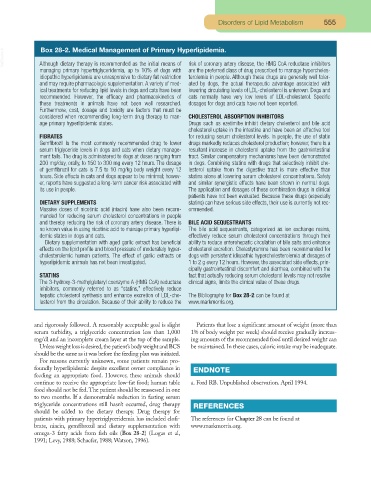Page 537 - Small Animal Clinical Nutrition 5th Edition
P. 537
Disorders of Lipid Metabolism 555
Box 28-2. Medical Management of Primary Hyperlipidemia.
VetBooks.ir Although dietary therapy is recommended as the initial means of risk of coronary artery disease, the HMG CoA reductase inhibitors
managing primary hypertriglyceridemia, up to 10% of dogs with are the preferred class of drug prescribed to manage hypercholes-
idiopathic hyperlipidemia are unresponsive to dietary fat restriction terolemia in people. Although these drugs are generally well toler-
and may require pharmacologic supplementation. A variety of med- ated by dogs, the actual therapeutic advantage associated with
ical treatments for reducing lipid levels in dogs and cats have been lowering circulating levels of LDL-cholesterol is unknown. Dogs and
recommended. However, the efficacy and pharmacokinetics of cats normally have very low levels of LDL-cholesterol. Specific
these treatments in animals have not been well researched. dosages for dogs and cats have not been reported.
Furthermore, cost, dosage and toxicity are factors that must be
considered when recommending long-term drug therapy to man- CHOLESTEROL ABSORPTION INHIBITORS
age primary hyperlipidemic states. Drugs such as ezetimibe inhibit dietary cholesterol and bile acid
cholesterol uptake in the intestine and have been an effective tool
FIBRATES for reducing serum cholesterol levels. In people, the use of statin
Gemfibrozil is the most commonly recommended drug to lower drugs markedly reduces cholesterol production; however, there is a
serum triglyceride levels in dogs and cats when dietary manage- resultant increase in cholesterol uptake from the gastrointestinal
ment fails. The drug is administered to dogs at doses ranging from tract. Similar compensatory mechanisms have been demonstrated
200 mg/day, orally, to 150 to 300 mg every 12 hours. The dosage in dogs. Combining statins with drugs that selectively inhibit cho-
of gemfibrozil for cats is 7.5 to 10 mg/kg body weight every 12 lesterol uptake from the digestive tract is more effective than
hours. Side effects in cats and dogs appear to be minimal; howev- statins alone at lowering serum cholesterol concentrations. Safety
er, reports have suggested a long-term cancer risk associated with and similar synergistic effects have been shown in normal dogs.
its use in people. The application and dosages of these combination drugs in clinical
patients have not been evaluated. Because these drugs (especially
DIETARY SUPPLEMENTS statins) can have serious side effects, their use is currently not rec-
Massive doses of nicotinic acid (niacin) have also been recom- ommended.
mended for reducing serum cholesterol concentrations in people
and thereby reducing the risk of coronary artery disease. There is BILE ACID SEQUESTRANTS
no known value in using nicotinic acid to manage primary hyperlipi- The bile acid sequestrants, categorized as ion exchange resins,
demic states in dogs and cats. effectively reduce serum cholesterol concentrations through their
Dietary supplementation with aged garlic extract has beneficial ability to reduce enterohepatic circulation of bile salts and enhance
effects on the lipid profile and blood pressure of moderately hyper- cholesterol excretion. Cholestyramine has been recommended for
cholesterolemic human patients. The effect of garlic extracts on dogs with persistent idiopathic hypercholesterolemia at dosages of
hyperlipidemic animals has not been investigated. 1 to 2 g every 12 hours. However, the associated side effects, prin-
cipally gastrointestinal discomfort and diarrhea, combined with the
STATINS fact that actually reducing serum cholesterol levels may not resolve
The 3-hydroxy-3-methylglutaryl coenzyme A (HMG CoA) reductase clinical signs, limits the clinical value of these drugs.
inhibitors, commonly referred to as “statins,” effectively reduce
hepatic cholesterol synthesis and enhance excretion of LDL-cho- The Bibliography for Box 28-2 can be found at
lesterol from the circulation. Because of their ability to reduce the www.markmorris.org.
and rigorously followed. A reasonably acceptable goal is slight Patients that lose a significant amount of weight (more than
serum turbidity, a triglyceride concentration less than 1,000 1% of body weight per week) should receive gradually increas-
mg/dl and an incomplete cream layer at the top of the sample. ing amounts of the recommended food until desired weight can
Unless weight loss is desired,the patient’s body weight and BCS be maintained. In these cases, caloric intake may be inadequate.
should be the same as it was before the feeding plan was initiated.
For reasons currently unknown, some patients remain pro-
foundly hyperlipidemic despite excellent owner compliance in ENDNOTE
feeding an appropriate food. However, these animals should
continue to receive the appropriate low-fat food; human table a. Ford RB. Unpublished observation. April 1994.
food should not be fed.The patient should be reassessed in one
to two months. If a demonstrable reduction in fasting serum
triglyceride concentrations still hasn’t occurred, drug therapy REFERENCES
should be added to the dietary therapy. Drug therapy for
patients with primary hypertriglyceridemia has included clofi- The references for Chapter 28 can be found at
brate, niacin, gemfibrozil and dietary supplementation with www.markmorris.org.
omega-3 fatty acids from fish oils (Box 28-2) (Logas et al,
1991; Levy, 1988; Schaefer, 1988; Watson, 1996).

